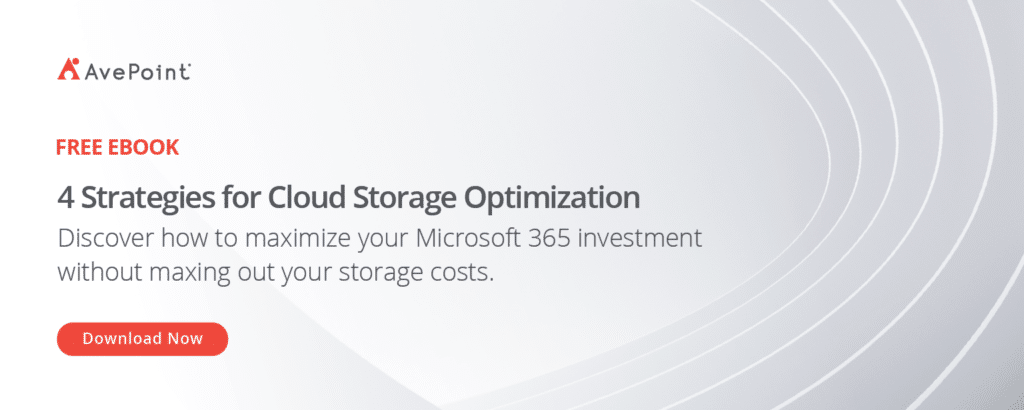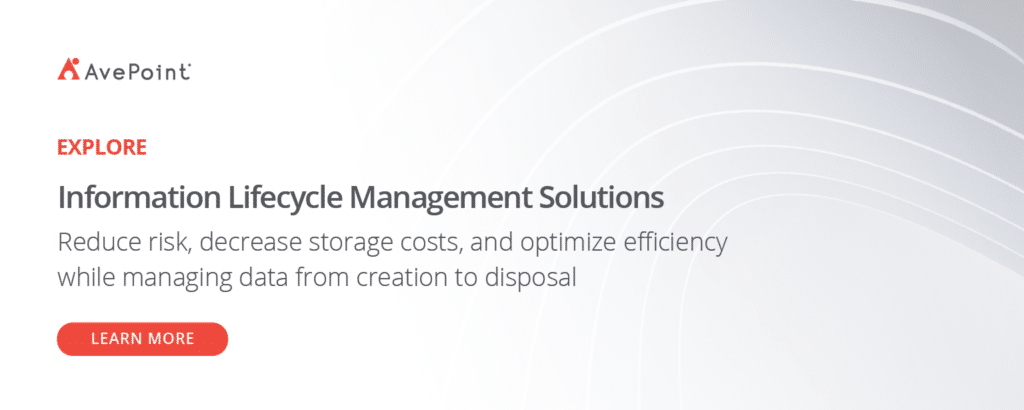Microsoft recently announced significant changes to the storage model for Microsoft 365 Education, which will take effect starting August 2024. The retirement of the Office 365 A1 Plus free plan and the reduction of pooled storage for education tenants to 100TB will impact many institutions. Here’s what IT leaders need to know and how AvePoint can help.
The Sea Change in Microsoft 365 Education Storage
Per Gartner’s recent report, How to Prepare for Microsoft 365 Education Storage Changes (Gartner subscription required for access), Microsoft’s move effectively ends the era of unlimited or very high storage quotas that many educational institutions have enjoyed. The reduced 100TB baseline will significantly impact organizations and require rethinking short-term and long-term data management strategies.
While Microsoft asserts most schools are currently below the new 100TB threshold, Gartner found numerous higher education institutions that will be massively affected. Some universities will exceed the new quota by hundreds of terabytes once it is enforced.
User profiles in education, like students, faculty, staff, alumni, and guest lecturers, are complex. Account lifecycles often do not follow clear patterns of creation, active use, and retirement. This complexity results in many stale accounts and unnecessary storage consumption that will need to be addressed.
Given past unlimited allowances, many educational organizations lack mature data retention and lifecycle policies to control information sprawl. Developing effective governance to meet the new constraints will be challenging.
Some higher education entities also store large volumes of research data in Microsoft 365 tools like OneDrive and SharePoint. This content has significant business value and will likely need to be re-evaluated.
Assessing the Impact
The shift from unlimited or very high pooled storage quotas to a 100TB baseline quota per tenant represents a major reduction for most education organizations. Many institutions are likely to face profound storage capacity challenges that will require extensive planning and preparation.
According to Gartner, some higher education organizations they spoke to will see storage decreases upwards of 90%. One client will go from a mammoth 5.7 petabytes to a much smaller 437 terabytes — a massive downgrade.
Institutions that have enjoyed virtually unlimited storage for years will now need to entirely change their approach.
To prepare, IT leaders at educational institutions must conduct an in-depth impact assessment. This involves thoroughly analyzing current Microsoft 365 storage consumption patterns and projecting future needs, such as:
- Checking your existing storage usage against the new 100TB quota to determine the gap.
- Performing detailed projections to account for continued growth in users, increased use and dependency on tools like Teams and OneDrive, and planned migrations of on-premises file shares or other systems.
- Modeling different scenarios to understand how changes like adding new campuses, launching new academic programs, or acquiring another institution might affect your storage needs.
It’s important to consider both short-term spikes and long-term trends. Storage needs ebb and flow in academia — intake of new students, the start of terms, and end-of-year activities can all represent periods of intense storage usage.
This in-depth impact assessment is essential to chart the right course. You need to realistically understand where your institution stands today, and where it’s headed in the future, and quantify the gap between your projected needs and the storage Microsoft will provide. This analysis provides the foundation to create a strategy.
Audit and Cleanup Recommendations
Gartner found that widespread content and workspace sprawl were top causes of Microsoft 365 storage pressure for many institutions. Their survey showed 58% of respondents cited content sprawl as a top three platform risk — highlighting the consequences of information spread across multiple siloed repositories.
An extensive audit and cleanup of your Microsoft 365 environment is crucial. Focus on meticulously identifying and removing stale, redundant, obsolete, and duplicate content.
This will require significant user communication and change management efforts to ensure community buy-in.
Start methodically reviewing all inactive OneDrive and mailbox accounts where users have left the organization. These often get overlooked but can build up substantially over time. OneDrive accounts, in particular, hold a trove of storage capacity that gets wasted by former students or employees. Develop detailed offboarding processes to manage account lifecycles.
Also carefully evaluate supposedly “active” accounts that show little real usage. Students that graduated years ago or employees who switched to new roles may still retain legacy accounts that consume storage. Rigorously look for unused SharePoint sites, Microsoft 365 Groups, and Teams without recent member activity. These teams and sites multiply quickly and are rarely revisited after their initial purpose ends.
For heavily utilized active accounts, break down storage consumption by users and services. Analyze the patterns by profile – students, staff, faculty members, alumni, and contractors. Look at trends by department or academic program as well.
This makes it easier to pinpoint accounts using excessive storage compared to peers. Leverage analytics tools to segment users by storage consumption patterns so you can tier cleanup efforts.
Evaluate the expanding adoption of archive mailboxes, which don’t count against pooled quotas. Set policies to automatically move emails older than a certain period to these secondary archives to limit the growth of crowded primary mailboxes.
Avoid overly broad retention policies that can prevent removing unneeded content. Microsoft 365 allows both organization-wide and targeted content retention rules, but blanket policies lead to bloat. File SharePoint and Teams meeting recordings can quickly accumulate and consume massive storage; these should be evaluated case-by-case versus organization-wide.
Managing storage growth requires assessing your information’s full lifecycle. Look at what content can be deleted immediately, what can be archived for occasional access, and what must be retained for regulatory compliance or business needs. This more granular approach reduces indiscriminate information accumulation.
AvePoint Opus for Full Lifecycle Management
To fully address Microsoft 365 storage challenges, meet AvePoint Opus — AvePoint’s next-generation AI-powered information lifecycle management solution enabling you to better manage information, reduce costs, and improve efficiencies.
As part of the AvePoint Confidence Platform’s Resilience Suite, AvePoint Opus is a comprehensive solution that enables organizations to discover, classify, protect, and manage their data across Microsoft 365 accurately and at scale.
A key component of AvePoint Opus is AvePoint Maestro, which uses AI models powered by Azure Machine Learning to analyze content and metadata and assign appropriate policies to documents.
With AvePoint Opus:
- Manage Information and Ensure Compliance: Automatic data classification, powered by AI, helps reduce the risks associated with information over-retention or accidental data deletion to meet compliance standards.
- Optimize Cloud Storage: Specific rules ensure organizations meet retention and disposal requirements to reduce excess cloud storage costs so that organizations maintain greater control over their budgets.
- Streamline Processes: Automatic records management removes time-intensive work, allowing organizations to focus on higher-value projects and speeding time-to-value for organizations seeking data-driven insights.
With deep Microsoft partnership and continued innovation, AvePoint is well positioned to help education institutions navigate these platform changes and ensure sound data management now and in the future. Discover AvePoint’s information lifecycle management solutions today.




